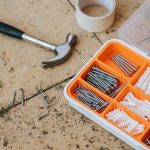Are you struggling with a tear in your cherished chiffon fabric? Don’t panic! This guide will walk you through the simple steps to fix it yourself.
By using common supplies and a little bit of patience, you can restore your chiffon fabric to its former glory.
Whether you’re dealing with a small snag or a larger tear, this article will provide you with the knowledge and techniques needed to repair it effectively.
Let’s get started!
Table of Contents
Identifying the Tear
Now, you’ll want to take a closer look at the tear in the chiffon fabric. Start by examining the fabric carefully to identify the tear location. Look for any visible signs of damage, such as frayed edges or a gap in the fabric. Pay attention to any loose threads or irregularities that may indicate the tear’s position.
Once you have identified the tear location, it is important to assess the severity of the damage. Check if the tear is small and minor or if it is larger and more significant. A small tear may require a simple repair, while a larger tear may need more extensive treatment.
To assess the tear severity, gently pull the fabric on both sides of the tear to see if it stretches or if the tear worsens. If the fabric stretches, it indicates that the tear is not too severe and can likely be repaired. However, if the tear worsens or the fabric tears further, it may require professional assistance or a more complex repair technique.
Gathering the Necessary Supplies
To mend the tear in your chiffon, you’ll need a few supplies. First, gather a needle and thread that matches the color of your chiffon fabric. Make sure the needle is sharp enough to easily pass through the delicate fabric without causing further damage. You will also need a pair of small, sharp scissors to trim any loose threads or excess fabric from the torn edges.
Once you have these supplies ready, you can proceed with the chiffon tear repair techniques. Start by carefully aligning the torn edges of the fabric, making sure they are perfectly matched. Using the needle and thread, begin stitching along the tear, using small, even stitches. Be gentle to avoid pulling or stretching the fabric. If the tear is large, you may need to use a technique called ‘invisible mending,’ where you create tiny stitches along the edges of the tear and then weave the thread through the fabric to create an almost invisible repair.
Remember to take your time and work slowly and methodically. With the right supplies and techniques, you can mend the tear in your chiffon and restore your garment to its former beauty.
Preparing the Chiffon Fabric
After gathering the necessary supplies, it’s important to carefully align the torn edges of the fabric before stitching. By taking the time to properly prepare your chiffon fabric, you can ensure a successful and seamless repair. Here are some steps to follow when preparing the chiffon fabric:
-
Pre-treating the chiffon fabric:
-
Gently hand wash the fabric using a mild detergent.
-
Rinse thoroughly and avoid wringing or twisting the fabric.
-
Lay the fabric flat on a clean towel and gently blot to remove excess water.
-
Allow the fabric to air dry completely before proceeding with the repair.
-
Fabric care:
-
Avoid using harsh chemicals or bleach on chiffon fabric, as it can weaken the fibers and cause further damage.
-
Store chiffon fabric in a cool, dry place to prevent moisture and mildew.
-
When ironing chiffon, use a low heat setting and place a thin cloth over the fabric to avoid direct contact with the iron.
Repairing the Tear With Hand Stitching
First, carefully thread your needle with a matching thread color to seamlessly repair the tear in the delicate chiffon fabric. Make sure the thread is securely knotted at the end.
Begin by gently bringing the two torn edges of the fabric together, aligning them as closely as possible. With your needle and thread, start stitching from the backside of the fabric, inserting the needle through one side of the tear and then through the other side. Repeat this process, creating small, evenly spaced stitches along the tear. Be cautious not to pull the thread too tightly, as it may cause the fabric to pucker.
Continue stitching until you have reached the end of the tear, then knot the thread on the backside of the fabric to secure it in place.
If the tear is larger or more complex, you may consider using alternative methods such as fabric glue or iron-on patches. These options provide quick and easy fixes for minor tears without the need for extensive hand stitching. However, for a more seamless and durable repair, hand stitching is the recommended method.
Fixing the Tear With Fusible Interfacing
When it comes to fixing a tear in fabric, using fusible interfacing can offer several benefits.
Not only does it provide extra strength and stability to the repaired area, but it also helps to maintain the fabric’s original drape and texture.
Applying fusible interfacing is a relatively simple process, and there are different techniques you can use depending on the size and location of the tear.
Lastly, when properly applied, interfacing can significantly increase the longevity of the repaired fabric, ensuring that the tear stays fixed for a long time.
Benefits of Interfacing
To fix a tear in chiffon fabric, you should consider using interfacing as it provides added stability and strength. Interfacing is a material that is applied to the backside of the fabric to reinforce it and prevent further tearing.
There are different interfacing techniques you can use, depending on the size and location of the tear. For small tears, you can cut a piece of interfacing slightly larger than the tear and place it behind the fabric. Then, using a hot iron, press the interfacing onto the fabric until it adheres. This method helps to strengthen the tear and prevent it from spreading.
The benefits of reinforcement with interfacing include extending the lifespan of the fabric, maintaining its original shape, and providing a smooth surface for stitching. By using interfacing, you can effectively repair and preserve your chiffon fabric.
Application Techniques for Interfacing
One way to reinforce and strengthen fabric is by applying interfacing using a hot iron. Interfacing is a versatile material that can be used to add structure, stability, and durability to various fabrics. Here are three application techniques and the benefits of using interfacing:
-
Fusible Interfacing: This type of interfacing has adhesive on one side, which is activated by heat. Simply place the interfacing on the fabric, cover it with a thin cloth, and press with a hot iron. The heat melts the adhesive, bonding the interfacing to the fabric. This method is quick and easy, providing instant reinforcement.
-
Sew-In Interfacing: This type of interfacing is stitched onto the fabric using a sewing machine or by hand. It offers a more permanent and secure bond, especially for heavy or delicate fabrics. Sew-in interfacing allows for more control and precision during the application process.
-
Interfacing Tape: This type of interfacing is in the form of a strip or tape. It is applied to the fabric by sewing or ironing. Interfacing tape is ideal for reinforcing seams or edges, providing extra strength and preventing fraying.
Benefits of Interfacing:
- Adds stability and structure to fabrics.
- Prevents stretching and distortion.
- Enhances the overall appearance and longevity of garments or projects.
Longevity of Repaired Fabric
Using interfacing to reinforce and strengthen fabric can significantly extend the lifespan of repaired garments.
When it comes to maintaining chiffon garments, it’s important to consider the longevity of the fabric after repairs. Chiffon is a delicate and lightweight fabric that requires special care to ensure its durability.
By using interfacing to repair tears in chiffon, you can help prevent further damage and increase the lifespan of the garment. Interfacing adds a layer of support and stability to the repaired area, making it less prone to tearing or fraying.
It provides a strong foundation for the delicate chiffon fabric, allowing it to withstand regular wear and tear. So, when repairing chiffon garments, don’t forget to incorporate interfacing to maintain the fabric’s longevity.
Finishing Touches and Care Tips
When it comes to ironing delicate chiffon, it’s important to use a low heat setting and a pressing cloth to avoid damaging the fabric.
As for storing your chiffon garments, hanging them in a cool, dry place is the best way to prevent wrinkles and keep them looking their best.
To prevent future tears, handle chiffon with care when wearing and washing, and avoid exposing it to sharp objects or rough surfaces.
Ironing Delicate Chiffon
To avoid damaging delicate chiffon fabric, it’s important to use a low heat setting when ironing. Chiffon is a lightweight and sheer fabric that can easily burn or melt under high heat. By using a low heat setting, you can safely remove wrinkles and creases without causing any damage. Additionally, it’s recommended to use a pressing cloth or a thin towel to provide an extra layer of protection between the iron and the fabric.
When ironing chiffon, it’s best to use a gentle pressing motion instead of dragging the iron across the fabric. This helps to prevent any unnecessary stretching or distortion. Remember to always iron on the wrong side of the fabric to avoid leaving any shiny marks or imprints.
If you’re unsure about ironing chiffon, there are alternative repair methods that you can try. One option is to use a fabric steamer, which provides a gentle and effective way to remove wrinkles without direct contact with the fabric. Another alternative is to hang the garment in a steamy bathroom, allowing the steam to naturally relax and smooth out the fabric.
To summarize, when ironing delicate chiffon fabric, use a low heat setting, use a pressing cloth or towel, and apply a gentle pressing motion. If you’re not comfortable ironing, consider using a fabric steamer or steam in a bathroom. These alternative methods can help maintain the integrity of the fabric while achieving a wrinkle-free look.
| Ironing Tips | Alternative Repair Methods |
|---|---|
| Use low heat | Use a fabric steamer |
| Use a pressing cloth or towel | Steam in a bathroom |
| Apply gentle pressing motion |
Storing Chiffon Garments
Now that you’ve learned how to iron delicate chiffon, let’s talk about storing chiffon garments to prevent tears.
Proper storage is essential for maintaining the delicate nature of chiffon fabric and ensuring it stays in good condition. To prevent tears, start by folding your chiffon garments rather than hanging them. Hanging can stretch the fabric and cause it to tear.
When folding, be gentle and avoid creasing the fabric too tightly. It’s also recommended to store chiffon garments in a cool, dry place away from direct sunlight. Excessive heat and sunlight can weaken the fibers and make them more prone to tearing.
Preventing Future Tears
You can avoid future tears by handling your delicate garments with care and being mindful of how you store them.
Preventing fraying starts with choosing the right thread. When repairing or sewing garments made of chiffon, it’s important to use a thread that matches the fabric’s weight and color. Opt for a lightweight thread that won’t put unnecessary strain on the delicate chiffon fibers. Additionally, consider using a thread that matches the color of your garment to minimize its visibility.
When storing your chiffon garments, always fold them gently and avoid hanging them, as this can cause stretching and tears. Store them in a cool, dry place away from direct sunlight.
Conclusion
So there you have it, a simple guide on how to fix a tear in chiffon fabric.
By following these steps, you can save your favorite chiffon garments from being ruined.
Remember to carefully identify the tear, gather the necessary supplies, and prepare the chiffon fabric before proceeding with the repair.
Whether you choose to hand stitch or use fusible interfacing, make sure to take your time and be gentle.
Lastly, don’t forget to give your repaired chiffon garment the proper care it needs to maintain its beauty and longevity.
- Where to Buy Sherpa Suede Fabric - July 12, 2025
- How to Draw or Illustrate the Texture of Suede Fabric - July 12, 2025
- What Is Baseball Suede Leather Fabric? - July 12, 2025






